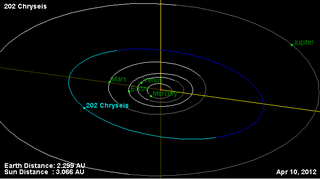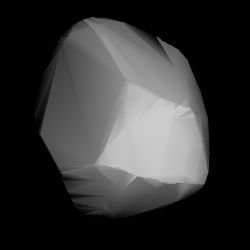
Dike is a quite large and dark main-belt asteroid. Dike was discovered by Alphonse Borrelly on May 28, 1868. It was his first asteroid discovery. This object is named after Dike, the Greek goddess of moral justice. Among the first hundred numbered minor planets, 99 Dike was considered anomalously faint for over a century. However, this was later found to be untrue.

Chryseïs is a large, lightly coloured Main belt asteroid that is probably composed of silicate rocks. It was discovered by C. H. F. Peters on September 11, 1879, in Clinton, New York, and was named after the mythical Trojan woman Chryseis.

Eudora is a large Main belt asteroid. It was discovered by French (Corsican) astronomer J. Coggia on August 30, 1880, in Marseilles, France. It was his fourth asteroid discovery and is named after Eudora, a Hyad in Greek mythology.

Oceana is an asteroid from the asteroid belt. It was discovered by Austrian astronomer Johann Palisa on 30 March 1882, in Vienna. It was named after the Pacific Ocean. Based upon its spectrum, it is classified as an M-type asteroid, but is not metallic.
Russia is a large Main belt asteroid. It is classified as a C-type asteroid and is probably composed of primitive carbonaceous material. It was discovered by Johann Palisa on 31 January 1883 in Vienna, who named it after the country of Russia.

Carolina is a sizeable Main belt asteroid. It was discovered by Austrian astronomer Johann Palisa on 28 November 1883 in Vienna, and was named after Caroline Island, now part of Kiribati in the Pacific Ocean. This asteroid is orbiting the Sun at a distance of 2.88 AU with a period of 4.89 yr and an eccentricity (ovalness) of 0.06. The orbital plane is tilted at an angle of 9.0° to the plane of the ecliptic.

Adrastea is a main belt asteroid. It was discovered by Johann Palisa on 18 August 1884 in Vienna, and was named after the Greek nymph Adrasteia. This asteroid is orbiting the Sun at a distance of 2.97 AU with a period of 5.11 years and an eccentricity (ovalness) of 0.23. The orbital plane is tilted at an angle of 6.17° to the plane of the ecliptic.

Regina is a typical, although fairly large, Main belt asteroid. It was discovered by Auguste Charlois on 3 August 1889 in Nice, France. The asteroid is a suspected interloper in the Eucharis asteroid family.

Fraternitas is a typical Main belt asteroid. It was discovered by Johann Palisa on 6 April 1891 in Vienna. The asteroid name is Latin for 'fraternity'; it was so named in order to commemorate the 25th anniversary of the Maturitätsprüfung Fraternity.

Florentina is an S-type (stony) main belt asteroid with a diameter of 28 km. It was discovered by Johann Palisa on 15 October 1891 in Vienna. He named the asteroid for his daughter, Florentine. Between 1874 and 1923, Palisa discovered a total of 122 asteroids.

May is a large Main belt asteroid. It was discovered by Auguste Charlois on 28 November 1892 in Nice, and was named for the German author Karl May. This asteroid is orbiting the Sun at a distance of 2.97 AU with a period of 5.12 years and an eccentricity (ovalness) of 0.067. The orbital plane is inclined at an angle of 9.7° to the plane of the ecliptic. During its orbit, this asteroid has made close approaches to the dwarf planet Ceres. For example, in September 1984 the two were separated by 6.3 Gm (0.042 AU).

Edburga is a typical Main belt asteroid. Max Wolf discovered it on 7 January 1896 at Heidelberg Observatory. The origin of the name is unknown. This asteroid is orbiting the Sun at a distance of 2.58 AU with a period of 4.15 yr and an eccentricity of 0.34. Its orbital plane is inclined at an angle of 18.7° to the plane of the ecliptic.
Natalie is a typical Main belt asteroid.
Reginhild is a minor planet orbiting the Sun that was discovered by German astronomer Max Wolf on September 19, 1905. The name may have been inspired by the asteroid's provisional designation 1905 RD.
Timandra is a minor planet orbiting the Sun that was discovered by American astronomer Joel Hastings Metcalf on February 16, 1906, in Taunton, Massachusetts.
780 Armenia is a minor planet in the asteroid belt orbiting the Sun. It is named after the Kingdom of Armenia, now Armenia. This object is orbiting at a distance of 3.11 AU with an eccentricity of 0.097 and a period of 5.50 yr. The orbital plane is inclined at an angle of 19.1° to the plane of rotation. This asteroid spans a girth of ~94 km. The long rotation period of this asteroid necessitated light curve data from more than one latitude. The overlapping data provided a solution with a period of 19.891±0.002 h and a brightness amplitude of 0.18±0.03 in magnitude.
912 Maritima is an asteroid in the asteroid belt. Based on lightcurve studies observing Maritima over a three-month period, Maritima has a rotation period of 1332 hours. Analysis reveals a possible synodic period of 1332±5 h. Superslow rotators, those with periods longer than a few days, are generally small asteroids. The current paradigm is that slowing of an asteroid's spin rate is the result of YORP radiation pressure, which acts on the target as the inverse square of its size and the inverse of its semi-major axis. The rotation period is less than conclusive.
996 Hilaritas is a Themistian asteroid. It was discovered in 1923 by Austrian astronomer Johann Palisa. Following Palisa's death in 1925, this asteroid was named for a "happy or contented mind"; qualities associated with the discoverer.
999 Zachia is a main-belt asteroid that was discovered by German astronomer Karl W. Reinmuth in 1923 and named after Hungarian astronomer Franz Xaver von Zach.
13241 Biyo, provisional designation 1998 KM41, is a background asteroid from the Flora region of the inner asteroid belt, approximately 4 kilometers (2.5 miles) in diameter. It was discovered on 22 May 1998, by the Lincoln Near-Earth Asteroid Research team (LINEAR) at the U.S. Lincoln Laboratory Experimental Test Site in Socorro, New Mexico. The presumed S-type asteroid has a rotation period of 4.4 hours and likely an elongated shape. It was later named after Filipino educator Josette Biyo.











